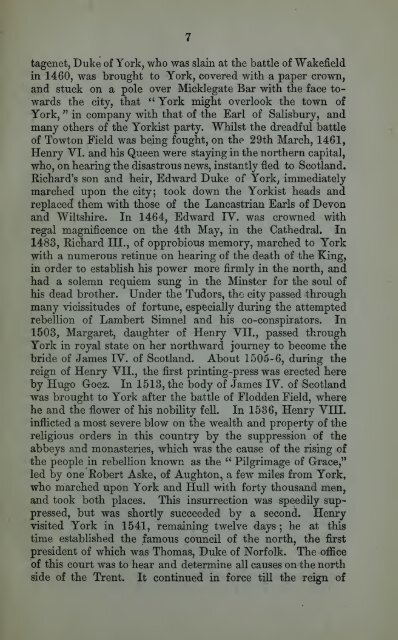practicalguideto00unse_0
You also want an ePaper? Increase the reach of your titles
YUMPU automatically turns print PDFs into web optimized ePapers that Google loves.
7<br />
tagenet, Duke of York, who was slain at the battle of Wakefield<br />
in 1460, was brought to York, covered with a paper crown,<br />
and stuck on a pole over Micklegate Bar with the face towards<br />
the city, that " York might overlook the town of<br />
York, " in company with that of the Earl of Salisbury, and<br />
many others of the Yorkist party. Whilst the dreadful battle<br />
of Towton Field was being fought, on the 29th March, 1461,<br />
Henry VI. and his Queen were staying in the northern capital,<br />
who, on hearing the disastrous news, instantly fled to Scotland.<br />
Eichard's son and heir, Edward Duke of York^ immediately<br />
marched upon the city; took down the Yorkist heads and<br />
replaced them with those of the Lancastrian Earls of Devon<br />
and Wiltshire. In 1464, Edward lY. was crowned with<br />
regal magnificence on the 4th May, in the Cathedral. In<br />
1483, Eichard III., of opprobious memory, marched to York<br />
with a numerous retinue on hearing of the death of the King,<br />
in order to establish his power more firmly in the north, and<br />
had a solemn requiem sung in the Minster for the soul of<br />
his dead brother. Under the Tudors, the city passed through<br />
many vicissitudes of fortune, especially during the attempted<br />
rebellion of Lambert Simnel and his co-conspirators. In<br />
1503, Margaret, daughter of Henry VII., passed through<br />
York in royal state on her northward journey to become the<br />
bride of James IV. of Scotland. About 1505-6, during the<br />
reign of Henry VIL, the first printing-press was erected here<br />
by Hugo Goez. In 1513, the body of James IV. of Scotland<br />
was brought to York after the battle of Flodden Field, where<br />
he and the flower of his nobility fell. In 1536, Henry VIIL<br />
inflicted a most severe blow on the wealth and property of the<br />
religious orders in this country by the suppression of the<br />
abbeys and monasteries, which was the cause of the rising of<br />
the people in rebellion known as the Pilgrimage of Grace,"<br />
led by one Eobert Aske, of Aughton, a few miles from York,<br />
who marched upon York and Hull with forty thousand men,<br />
and took both places. This insurrection was speedily suppressed,<br />
but was shortly succeeded by a second. Henry<br />
visited York in 1541, remaining twelve days ;<br />
he at this<br />
time established the famous council of the north, the first<br />
president of which was Thomas, Duke of Norfolk. The ofiice<br />
of this court was to hear and determine all causes on the north<br />
side of the Trent. It continued in force till the reign of















